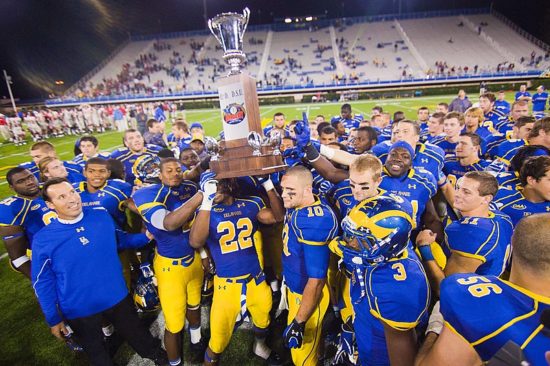6 strategies to breakthrough to ‘elite’ status

What are the keys to helping your team breakthrough to the elite level? Being privileged to work with dozens of teams that have made it, here are six strategies I’ve found you can use to become “elite.”
1. Don’t limit yourself or your team.
First and foremost, be careful not to limit yourself and team because you believe there is some insurmountable obstacle that won’t let you breakthrough to the elite level. As legendary UCLA basketball coach John Wooden discovered, sometimes the biggest obstacle is yourself — not your opponents.
Wooden initially convinced himself that there was no way he was ever going to get the best recruits to come to UCLA because of his antiquated men’s gym. Wooden writes in his excellent book, “Wooden on Leadership:”“I’d been coaching basketball at UCLA for 13 years in conditions I would describe as harsh, perhaps as bad as any major university in the country. Our practice facility, the men’s gym, was cramped and poorly ventilated and often jammed with student-athletes participating in other sports activities during our basketball practices …
“Additionally, the seating area for fans was so limited that is was declared a fire hazard and ‘home’ games were subsequently played at other local schools. The facility also hurt us when it came to attracting players with exceptional talent. Many, no doubt, chose programs that offered decent facilities.
» ALSO SEE: Captains must do these 12 things today
“I was confronted with this situation immediately upon my arrival at UCLA and soon concluded it was virtually impossible to achieve my goals under such conditions. It also had an impact on my assessment of the possibility of winning a national championship; specifically, in the back of my mind I just felt there was no chance that UCLA would ever be able to go all the way.”
Wooden admits that his pessimistic perspective hurt his program because of the mental barrier he put on himself and his team. He said, “We can limit ourselves and our organization without even knowing — how we can say ‘no’ when we should be asking ‘how?’
“Once I realized our practice facility did not preclude a national championship, it shook me out of some form of complacency or perhaps subconscious excuse making,” Wooden continued. “It’s hard to describe except to say that I came to realize that issues I couldn’t control — the men’s gym and what it forced upon us — had interfered with those thing I could control, such as ceaselessly and creatively searching for ways to improve and reach the next level of competition.
“By giving myself that crutch, I may have gotten comfortable with the way things were — not happy, but comfortable. I would never again allow myself to be satisfied that UCLA had gotten as good as we could get, improved as much as we could improve.”
Rather than accepting the limitation of his poor facilities that would prevent him from building an elite program, Wooden focused instead on the other things he could do to make UCLA an attractive option for recruits. He didn’t let the rundown gym “excuse” keep him from winning 10 national championships.
2. Recruit talent and toughness.
One of the biggest keys to helping your team ascend to the elite level is finding the top talent for your team. To consistently compete for championships, you need supremely talented athletes. As part of Arizona softball’s rise to a dominant program in the 1990s, coach Mike Candrea was able to wrestle away some top recruits like Jenny Dalton and Nancy Evans from perennial champion UCLA. These big-time breakthrough recruits provided Arizona with the key talent necessary to win championships.

However, it is important not to overlook that these key breakthrough athletes had talent and toughness. In addition to their physical skills, Dalton, Evans and many of the other recruits had a certain mental toughness that was a big key to their success. They were highly competitive, worked hard, played with confidence and had a deep desire to win championships. These toughness factors were as much a part of their program’s success as their talent.
3. Develop strong team leaders.
Strong leaders are critical to reach the elite level. It can’t just be the coaching staff driving the team to the top, it must be led by the team too. As former NFL coach Marty Schottenheimer once said, “The most successful teams that I’ve been around were those where the players drove the machine.”
Your leaders are the key to this. You must develop a strong cadre of leaders who are as passionate, determined and as competitive as you are to win championships. Not only will they model the kind of effort necessary to be the best, they will inspire and hold the rest of the team accountable to it too. Be sure to invest extra time in developing, communicating with and troubleshooting with your leaders.
4. Create a culture that expects success.
With the help of your leaders, it’s also important to create a culture that expects success. En route to a breakthrough season and winning the 2006 national championship, Maryland women’s basketball coach Brenda Frese took her team on a special side trip to the Final Four site in Boston when playing a regular season game against Boston College.
In the book “Overtime is Our Time,” former Maryland player Laura Harper said of the special field trip, “I don’t think we had really put Boston in perspective. This is where the Final Four is played — the championship,” Harper said. “Her taking us there was like, ‘We can do this, guys.’ Coach B believes in us was more than we believe in ourselves. She was like, ‘Do you guys realize this is there we can be in a couple of months if we handle our business?’” The Bruins were playing that night, so ice covered the arena floor, but the Terps got the message. They sat in the stands, admiring the 16 championship banners the Celtics had earned while envisioning the opportunity to win a title of their own.”
When you are at the breakthrough level, put up pictures of your team’s final championship destination whether it is Omaha for baseball, Oklahoma City for softball or whatever this year’s site of the state or national championship is for your sport. Let your athletes see the vision you have for the program and your belief that it is within reach.
By seeing the vision every day, it provides them with ongoing motivation and meaning for all the grueling training they’re putting in. The vision of the desired destination transforms all the necessary hard work from a dreaded sacrifice into an important investment in the team’s goal.
5. Competitors find a way to win.
Despite obstacles, adversities, setbacks, and oftentimes having to compete against better teams, competitive teams often find a way to win. Fan the competitive flames of your team to provide your athletes with an extra source of motivation that can take you over the top.
In my “How to Develop Relentless Competitors” book, I focus on five sources of competitive advantage you can create for your team:
- Claiming new territory (achievement).
- Defending your own territory (protection).
- Being treated as a second-class citizen (respect).
- Representing your people (pride).
- Leaving a legacy (reputation).
Find one or more of these five sources that appeals the most to your team. For example, the San Antonio Spurs felt like they had given away an NBA Championship during the 2013 season with a tough game six loss to LeBron James and the Miami Heat. Tim Duncan, Tony Parker, Manu Ginobli, Gregg Poppovich and the rest of the team felt like they had something to prove during the 2014 season and played like it.
The Spurs came back and reclaimed the championship they felt was rightfully theirs. Give your team something to prove this season, and it will often provide you with the extra motivation necessary to breakthrough to the elite level.
6. Confidence is key.
 Confidence is critical to breaking through to the elite level. You have to get yourself and your players to believe you deserve to win just as much as any powerhouse opponent. Many coaches schedule tough opponents early in the season so that their teams can get a feel for what it’s like to play them. For example, Florida women’s soccer coach Becky Burleigh intentionally scheduled numerous scrimmage and competitive matches against perennial national champion North Carolina when she first started the program.
Confidence is critical to breaking through to the elite level. You have to get yourself and your players to believe you deserve to win just as much as any powerhouse opponent. Many coaches schedule tough opponents early in the season so that their teams can get a feel for what it’s like to play them. For example, Florida women’s soccer coach Becky Burleigh intentionally scheduled numerous scrimmage and competitive matches against perennial national champion North Carolina when she first started the program.
“Instead of some teams being afraid to play those good teams because they don’t want to get crushed, we just played them,” she said. “And we didn’t really hedge anything when we played them. We just played them straight up and usually that meant a pretty good whacking but at the same time it let us learn about ourselves a little quicker.
“But then, we played Carolina at home, and we lost 2-1 to them in overtime and it was a really competitive game. It was the first time we had ever really been competitive with them. At that point we said, “Why are we just thinking about trying to get to the Final Four? We need to be thinking about winning it.”
Despite the loss, Florida actually gained confidence and knew that it could compete with any team. They didn’t think Carolina was untouchable but could be beaten with great effort and strategy. The match was a turning point in helping Florida develop the confidence and competitiveness necessary to win a national championship.
If you beat the powerhouse team, you can use it as example that your team can win at the highest level. If you lose to the top-ranked team, you can convert it into an opportunity to seek revenge should you face them again in the playoffs.
Legendary Tennessee women’s basketball coach Pat Summitt said, “If you want to be the best, you have to compete against the best, even if it means risking a loss. Why seek out weak competition? The secret to our success in the post season is that we have already played most of the teams we will face. Frequently we have lost to them earlier in the season and are seeking competitive revenge.”
You and your team can breakthrough to the elite level. Use the strategies above to help your and your team climb the mountain of success. It is not an easy process, but if you have the culture, confidence and competitiveness in your favor, it can be done.
For more tips and articles, visit the Janssen Sports Leadership Center website.





